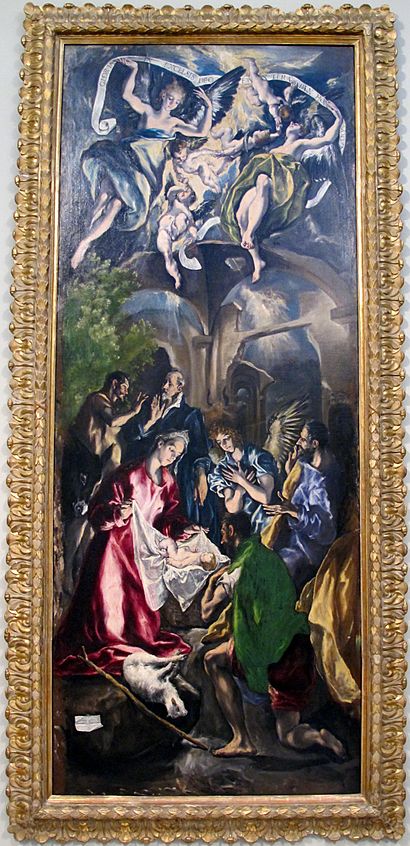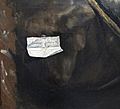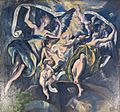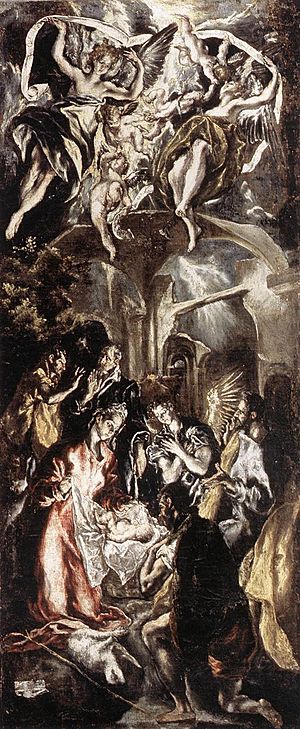The Adoration of the Shepherds (El Greco, Bucharest) facts for kids
Quick facts for kids The Adoration of the Shepherds |
|
|---|---|
 |
|
| Artist | El Greco |
| Year | 1596 |
| Medium | Oil on canvas |
| Dimensions | 364 cm × 137 cm (143 in × 54 in) |
| Location | National Museum of Art of Romania, Bucharest |
The Adoration of the Shepherds is a famous painting by the artist El Greco. He painted it in 1596. This artwork shows a traditional scene from the Bible. It is about the shepherds visiting baby Jesus after he was born. You can see this painting in the European art collection at the National Museum of Art of Romania in Bucharest.
This painting is very tall. It was part of a larger project El Greco worked on in 1596. This project was called the Doña María de Aragón Altarpiece. It was made for a chapel in Madrid, Spain. El Greco's signature is on the painting. You can find it in Greek on a piece of paper in the bottom left corner.
Records show the painting was supposed to be finished by Easter 1599. However, it was shipped from Toledo to Madrid in 1600. El Greco received his final payment for the "high altar" in September of that year.
About the Original Artwork
We don't know much about how El Greco planned the full altar. We also don't know how high the paintings were displayed. The original artwork was a big project. It included six paintings and six sculptures. These artworks showed the idea of Jesus becoming human. This was a big topic in Spain at the time.
The altarpiece was taken apart in the early 1800s. This happened when the French took over Spain under Joseph Bonaparte. The sculptures from the altarpiece are now lost. The other five paintings were moved to the Prado Museum.
Two Worlds in One Painting
Many of El Greco's paintings, like The Adoration of the Shepherds, show bodies that look stretched or unusual. We don't know if he painted them this way on purpose. Sometimes these paintings were placed low to the ground. Other times they were high up.
In this painting, El Greco shows two different worlds. The bottom part of the painting shows the everyday world. The top part shows the divine, or heavenly, world. It was hard to display such tall paintings. Because of this, some of El Greco's tall artworks were cut in half. For example, the heavenly part of one painting is now called Concert of Angels and is in Athens. The earthly part is called Opening of the Fifth Seal and is in New York.
-
This is an earlier version of the same scene. El Greco painted it in 1568 for the Modena Triptych.
-
Here's another painting by El Greco with the same theme. He painted this one around 1597. It is now in the Metropolitan Museum of Art.
Other Versions and History
El Greco painted many scenes of Jesus' birth. These "nativity scenes" were very popular during his life. In 1621, his son's records showed six of these paintings. This might explain why The Adoration of the Shepherds was separated from the altarpiece. It was likely a very popular subject. A smaller copy of this painting, made in 1598, is in the Galleria Nazionale d'Arte Antica in Rome.
The land for the chapel where the altarpiece was placed was given in 1581. It was for a group of nuns. The chapel was named after Dona Maria de Aragón. She was a lady-in-waiting to the queen, Dona Ana de Austria. Dona Maria de Aragón started the process for the altarpiece in 1596. She died before El Greco was paid in 1600. El Greco delivered the paintings in July 1600.
The altarpiece stayed together until 1808. After it was taken apart, it was no longer on display there. In 1836, Baron Taylor bought this painting for King Louis Philippe. Later, it was sold to the Péreire brothers in Paris. After another sale in 1868, it went to Félix Bamberg. In 1879, the painting was bought for the Royal Palace in Sinaia.
See also
 In Spanish: Adoración de los pastores (Retablo de María de Aragón) para niños
In Spanish: Adoración de los pastores (Retablo de María de Aragón) para niños







